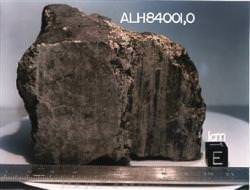Our old friend and headline-maker is back in the news. Meteorite ALH84001 — the Mars rock that sent the world of astrobiology into a tizzy back in 1996 — hasn’t been just sitting around collecting dust. Researchers have been re-examining the famous meteorite in an effort to learn more about the early history of Mars. Not only did ALH84001 help determine that the building blocks of life actually did form on early Mars, but also that those same building blocks have the potential to form on a cold rocky planet anywhere in the Universe.
The meteorite, found in the Alan Hills region of Antarctica, grabbed the headlines over 11 years ago when scientists claimed to have found the remains of bacteria-like life forms within the rock from Mars. The claims have been hotly debated, with both sides still holding firm in their convictions.
But scientists at the Carnegie Institution’s Geophysical Laboratory took the research into ALH84001 a step further, and have shown for the first time that building blocks of life formed on Mars early in its history. Organic compounds that contain carbon and hydrogen form the building blocks of all life here on Earth. Previously, some scientists thought that organic material in ALH84001 was brought to Mars by meteorite impacts, and others felt the material might have originated from ancient Martian microbes, while still others thought any organics in the rock probably were introduced after it arrived on Earth.
The Carnegie-led team made a comprehensive study of the ALH 84001 meteorite and compared the results with data from related rocks found on Svalbard, Norway. The Svalbard samples came from volcanoes that erupted in a freezing Arctic climate about 1 million years ago — possibly mimicking conditions on early Mars.
“Organic material occurs within tiny spheres of carbonate minerals in both the Martian and Earth rocks,â€? said Andrew Steele, lead author of the study. “We found that the organic material is closely associated with the iron oxide mineral magnetite, which is the key to understanding how these compounds formed.”
“The results of this study show that volcanic activity in a freezing climate can produce organic compounds,” said Hans E.F. Amundsen, a co-author in the study from Earth and Planetary Exploration Services. “This implies that building blocks of life can form on cold rocky planets throughout the Universe.”
The organic material in the Allan Hills meteorite may have formed during two different events. The first, similar to the Svalbard samples, was during rapid cooling of fluids on Mars. A second event produced organic material from carbonate minerals during impact ejection of ALH84001 from Mars.
“Our finding sets the stage for the Mars Science Laboratory (MSL) mission in 2009,” said Steele, who is a member of the Sample Analysis on Mars (SAM) instrument team onboard MSL. “We now know that Mars can produce organic compounds. Part of the mission’s goal is to identify organic compounds, their sources, and to detect molecules relevant to life. We know that they are there. We just have to find them.”
This makes the MSL mission all the more exciting and anticipated. And perhaps the team of scientists who made the claims about microbes in ALH 84001 back in 1996 have something to strengthen their case.
Original News Source: Carnegie Institution For Science Press Release

